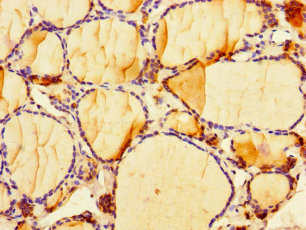
Immunohistochemistry of paraffin-embedded human thyroid tissue using CSB-PA850790LA01HU at dilution of 1:100
CIART Antibody
CSB-PA850790LA01HU
ApplicationsELISA, ImmunoHistoChemistry
Product group Antibodies
ReactivityHuman
TargetCIART
Overview
- SupplierCusabio
- Product NameCIART Antibody
- Delivery Days Customer20
- ApplicationsELISA, ImmunoHistoChemistry
- CertificationResearch Use Only
- ClonalityPolyclonal
- ConjugateUnconjugated
- Gene ID148523
- Target nameCIART
- Target descriptioncircadian associated repressor of transcription
- Target synonymsC1orf51, CHRONO, GM129, circadian-associated transcriptional repressor, chIP-derived repressor of network oscillator, computationally highlighted repressor of the network oscillator
- HostRabbit
- IsotypeIgG
- Protein IDQ8N365
- Protein NameCircadian-associated transcriptional repressor
- Scientific DescriptionTranscriptional repressor which forms a negative regulatory component of the circadian clock and acts independently of the circadian transcriptional repressors: CRY1, CRY2 and BHLHE41. In a histone deacetylase-dependent manner represses the transcriptional activator activity of the CLOCK-ARNTL/BMAL1 heterodimer. Abrogates the interaction of ARNTL/BMAL1 with the transcriptional coactivator CREBBP and can repress the histone acetyl-transferase activity of the CLOCK-ARNTL/BMAL1 heterodimer, reducing histone acetylation of its target genes. Rhythmically binds the E-box elements (5-CACGTG-3) on circadian gene promoters and its occupancy shows circadian oscillation antiphasic to ARNTL/BMAL1. Interacts with the glucocorticoid receptor (NR3C1) and contributes to the repressive function in the glucocorticoid response (By similarity).
- ReactivityHuman
- Storage Instruction-20°C or -80°C
- UNSPSC41116161




